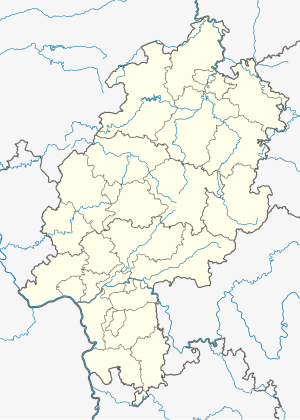Lohbergtunnel (high-speed line Hanover-Würzburg)
| Lohberg tunnel | ||
|---|---|---|
| traffic connection | High-speed line from Hanover to Würzburg | |
| place | kassel | |
| length | 1072 m | |
| Number of tubes | 1 | |
| construction | ||
| Client | German Federal Railroad | |
| business | ||
| operator | DB network | |
| location | ||
|
|
||
| Coordinates | ||
| North portal | 51 ° 21 ′ 9 " N , 9 ° 32 ′ 30" E | |
| South portal | 51 ° 20 ′ 54 " N , 9 ° 31 ′ 44" E | |
The Lohbergtunnel is a 1072 m long railway tunnel on the high-speed line Hanover – Würzburg near Kassel .
In the planning and construction phase, the tunnel was planned with a length of 563 m. The part of the Kahnwiese intersection building immediately to the south, which was constructed as a frame, was later added to the tunnel.
course
The new line coming from Göttingen reaches Ihringshausen via the tunnel . The initially straight route goes towards Kassel in a right curve in a westerly direction.
In the closed part of the crossing structure, the southern track of the existing line crosses the tracks of the new line at an acute angle. The two tracks of the existing line run parallel to each other at the north-eastern end of the structure on the west side in an elevated position, while to the east of this the two new railway tracks are in a lower position. At the end of the closed part of the crossing structure, which is now part of the Lohberg tunnel , the trough structure of the Kahnwiese crossing structure connects .
At 51 ° 20 ′ 56.2 ″ N , 9 ° 32 ′ 4.2 ″ E , an emergency exit from the tunnel leads to an adjacent street.
After a short section to the north, the Lohberg tunnel is followed by the Kragenhof Fuldatal Bridge . To the west, after nine kilometers, is the Kassel-Wilhelmshöhe train station .
The structure lies between the route kilometers 134.2 and 135.3. In the northern part (up to km 134.4) the maximum permissible speed is 160 km / h, in the remaining part it is 140 km / h.
history
planning
The structure was part of planning section 11 in the middle section of the new line.
In 1984 the structure was planned to be 563 m long.
construction
The start of construction on the Lohberg Tunnel was celebrated in October 1984. The contract value for the tunnel was 18.1 million D-Marks.
The tunnel, covered between 5 and 22 m, was to be 352 m long using the new Austrian tunnel construction method (coming from the north portal). The remaining 210 m (towards the southwest) were to be constructed using the open construction method. The framework structure of the Kahnwiese intersection is directly connected to this cut-and-cover tunnel. The tunnel cuts through middle red sandstone, which is covered by debris and loess loam. After completion of the construction work, the tunnel was covered with one meter in the southwest and around 20 m in the northeast.
In the course of the construction work, 107,000 m³ of earth were moved, of which 50,000 m³ were excavated from the tunnel and 54,000 m³ for the preliminary cut. In return, 6,000 m³ of shotcrete , 34,000 running meters of anchors , 18,000 m³ of in-situ concrete and 1,200 t of structural steel were poured in.
In April 1985, construction began on the Kahnwiese crossing structure. The 950 m long structure consists of a closed frame with 55 blocks (484 m) and a U-shaped trough structure with 53 blocks (466 m). The frame has a clear width of 12.30 m and a height of 6.90 m above the top of the rail .
Most of the excavation from the 950 m long intersection structure (110,000 m³) was used for noise protection walls along the route. The order total was around 28 million DM. The clayey silts found in the area of the crossing structure were considered to be extremely poor building ground, as they release water very slowly and settle in the long term. The layers of gypsum and lignite that were found in places turned out to be an even more difficult building site. The structure was therefore founded over almost its entire length on 760 large in-situ concrete bored piles with a total length of 8343 m.

The existing tracks were laid several times in several steps during the construction process.
In the course of the project, two pedestrian bridges were built over the tracks and a supply channel under the trough.
Heid & Franke ( Munich ) was commissioned with the construction of the original Lohberg tunnel . The NBS project group at the Federal Railroad Directorate Frankfurt am Main of the Deutsche Bundesbahn acted as the client .
Installation
The structure was put into regular operation in 1991 together with the Kassel – Fulda section.
Individual evidence
- ↑ a b c d e Deutsche Bundesbahn, project group H / W Mitte der Bahnbauzentrale (ed.): Kahnwiese crossing structure , six-sided leporello, approx. 1986.
- ↑ a b Bundesbahndirektion Frankfurt (M), project group NBS Frankfurt am Main of the Bahnbauzentrale (publisher): New routes Hanover-Würzburg from Kassel to Fulda, Cologne - Rhine / Main in the directorate area . Leaflet with 12 pages (10x21 cm), Frankfurt am Main, no year (approx. 1984)
- ↑ a b c d Deutsche Bundesbahn, project group H / W Mitte der Bahnbauzentrale (ed.): Lohberg tunnel , six-sided leporello, approx. 1986.
- ↑ a b c Wayss & Freytag AG: Structures in the course of the new Hanover-Würzburg line of the Deutsche Bundesbahn in the Kassel area . ( Technical sheets of Wayss & Freytag AG , 1/88), 16 pages, pp. 2–6.

